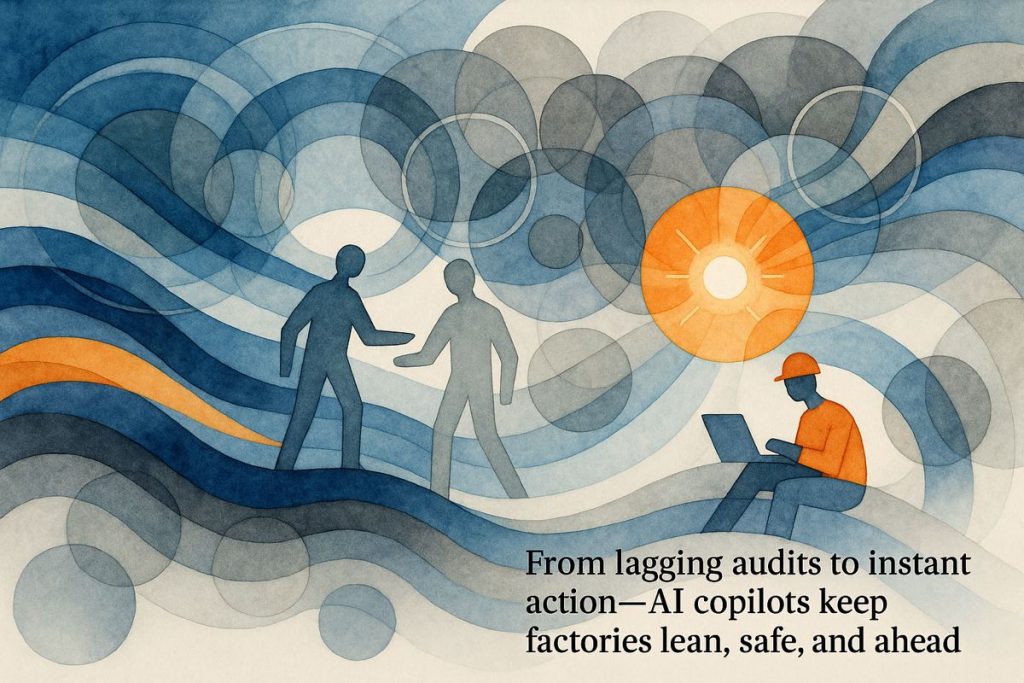Retrocausal’s real-time AI copilots make factories smarter by spotting mistakes instantly and giving quick feedback, so problems don’t grow out of control. These AI helpers connect smoothly with old systems and keep learning, always suggesting how to make things better. Instead of waiting for slow audits or missing errors, workers get alerts right away, helping them fix issues before they become big headaches. The AI copilots are easy to set up, don’t need coding, and feel like always having a careful expert watching out for everyone on the line. The result? Fewer defects, more efficiency, and a calmer, more confident factory floor.
What are the benefits of Retrocausal’s real-time AI copilots for lean manufacturing?
Lean Manufacturing’s Old Shoes (And Why They Barely Fit Anymore)
You remember the first time you saw a kanban board outside of a textbook? I do. It was taped to a machine in a fluorescent-lit factory, the edges curling up like stale toast. The manager—let’s call him Vladislav—swore by it. But even Vlad admitted, between sips of week-old coffee, that nothing on that board ever moved fast enough to catch mistakes before they snowballed.
That’s always been lean manufacturing’s Achilles’ heel. It’s rigorous, yes; elegant, sometimes; but let’s be honest: audits and process checks have all the reactivity of a steamboat turning mid-river. By the time a deviation is detected, it’s often already metastasized—like a rumor in the break room, or misassembled semiconductors on an automotive line (ask Toyota, circa 2022, about their unplanned “learning opportunity”).
Enter Retrocausal. The company’s name alone feels like a paradox—effects before causes? And yet, in an industry allergic to ambiguity, Retrocausal is peddling something that feels downright hyperspectral: real-time AI copilots. Imagine an extra set of eyes (or a thousand) that never blink, don’t get bored, and will point out your mistakes before your supervisor can even say “gemba walk.”
A few years back, I was skeptical. I thought, “Is this another Industry 4.0 mirage?” But watching those AI copilots in action—seeing a missed bolt flagged before it hits the next station—was a revelation. Like watching an orchestra perform with a silent metronome, every beat perfectly in sync.
From Retro to Real-Time: How Copilots Bridge the Temporal Chasm
Let’s address the elephant in the factory: speed. Traditional lean processes are retrospective by design—think of them as reading tea leaves after the tea’s gone cold. You’re forever chasing yesterday’s ghosts. By contrast, Retrocausal threads AI directly into the factory’s circulatory system, sampling real-time data from cameras, IoT doodads, and your trusty MES (Manufacturing Execution System).
In my own trials, the Assembly Copilot felt a bit like a stern but fair craftsman—always watching, rarely scolding, but quick to chime in if my hands wandered. The system’s feedback was so precise, I could almost feel the heat of its virtual gaze on my neck. Unnerving? A little. Effective? Absolutely.
The Kaizen Copilot, meanwhile, is like an ever-curious apprentice who never tires—armed with LeanGPT (yes, you heard right: an actual generative AI for manufacturing). It doesn’t just suggest improvements; it learns from your floor’s unique rhythm, compiling operator insights and gemba walk notes into a living, breathing palimpsest of process wisdom. If you’ve ever wished you could bottle the tacit know-how of your best line lead and distribute it worldwide, well…bam! Here’s your chance.
Deep dive: Kaizen Copilot in SiliconANGLE
Immediate Feedback: The Sensory Pulse of Modern Manufacturing
Let’s not mince words: the real magic is in the instantaneity . With AI copilots woven into the warp and weft of daily operations, problems don’t become tomorrow’s headaches. They’re intercepted mid-breath. Think of the system as sonar for workflow anomalies—pinging for bottlenecks, lulls, or suspicious operator motions.
I still remember the first time the Kaizen Copilot flagged a high-risk interval—a lull on an electronics assembly cell, the hum of absent productivity almost palpable. My initial reaction? A mix of surprise and faint embarrassment (was I being watched by HAL 9000’s earnest nephew?). But the follow-up dialog from the AI, suggesting a gentle workflow tweak, felt as natural as the aroma of solder and hot plastic wafting through the air.
Alerts materialize onscreen, often accompanied by a soft chime—neither jarring nor easy to ignore—and corrective action can be taken before a single defect escapes to the next process. The emotional undertone? Relief, mostly. And, perhaps, a tiny pang of regret I didn’t have this back in 2019 when a single missing screw cost my team two weeks of rework.
Integration, Security, and the Messy Beauty of Progress
I’ll admit, the first time I tried setting up a monitoring task, I was certain I’d botched it. But, after a sheepish double-check, the Copilot had my back—no code, no tears.
Privacy? That’s not just a checkbox—especially when you’re collecting hyperspectral video data
